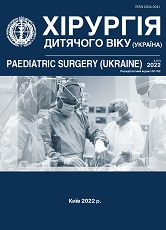Videothoracoscopic removal of a foreign body (arrow-shaped element) of gunshot origin from the vertebral body, using radiation and magnetic technologies
DOI:
https://doi.org/10.15574/PS.2022.77.96Keywords:
gunshot wounds of the chest, video thoracoscopy, radiation control, magnetic technologiesAbstract
Gunshot wounds to the chest have always occupied a special place among the entire set of gunshot wounds on the human body. Today, the one of the important challenges before the Navy of the Armed Forces of Ukraine, - not only to restore the damaged anatomical structures of the chest, but also to create optimal conditions for the restoration of the functional component. This will make possible to reduce the treatment period of a wounded serviceman and return him to the formation (or to the occupied position) as soon as possible.
The use of minimally invasive methods (videothoracoscopy, radiation control and magnetic technologies) during the treatment of a wounded person with a penetrating gunshot wound of the chest is the key in the surgeon’s hands whose task is to save life and eliminate the defect (formed as a result of the wound). This approach is not only an example of highly specialised surgical care for the wounded in the navy, but also demonstrates the high quality of the proposed care scheme.
Purpose - practically implement new organisational, tactical and professional approaches to the treatment of gunshot wounds to the thorax using a clinical case study.
It is presented the clinical case of wounded man Sh., 35 years old, with a gunshot fragmentation blind wound of the posterior surface of the thorax, gunshot fracture of the Th7 vertebral body on the background of a foreign body (metal arrowhead).
In the current world literature, there are many options for surgical tactics for the treatment of wounded patients with penetrating gunshot wounds to the chest. However, our clinical case draws attention to the high relevance of applying and combining minimally invasive techniques (video-othoracoscopy, radiation control and magnetic technology). This makes it possible to reduce the time (or duration) of surgical intervention, perform an «extended» revision of the pleural cavity, examine and assess the condition of the wound canal, remove a foreign body (shrapnel, bullets, arrowhead component), compensate for respiratory failure phenomena as quickly as possible and restore the integrity and function of the thoracic cells.
The research was carried out in accordance with the principles of the Helsinki Declaration. The informed consent of the patient was obtained for conducting the studies.
No conflict of interests was declared by the authors.
References
Boyd AD, Glassman LR. (1997). Lung injury. Chest Surg Clin N Am. 7: 263-284.
Hirsch M, Carli P, Nizard R, Riou B, Baroudjian B, Baubet T et al. (2015). The medical response to multisite terrorist attacks in Paris. Lancet Lond Engl. 386: 2535-2538. https://doi.org/10.1016/S0140-6736(15)01063-6; PMid:26628327
Keneally R, Szpisjak D. (2013). Thoracic trauma in Iraq and Afghanistan. J Trauma Acute Care Surg. 74: 1292-1297. https://doi.org/10.1097/01586154-201305000-00016; PMid:23609281
Lesquen HD, Beranger F, Berbis J, Boddaert G, Poichotte A, Pons F et al. (2016). Challenges in war-related thoracic injury faced by French military sur-geons in Afghanistan (2009-2013). Injury. 47: 1939-1944. https://doi.org/10.1016/j.injury.2016.06.008; PMid:27418455
Lo Cicero J 3rd, Mattox KL. (1989). Epidemiology of chest trauma. Surg Clin North Am. 69: 15. https://doi.org/10.1016/S0039-6109(16)44730-4; PMid:2911786
Mykhailosov RM, Velikodny OM, Bilenky VA, Negoduyko VV, Borodai VO. (2015). Utility model patent No. 105452 (UA). A flexible device for removing ferromagnetic foreign bodies. Submitted on August 4, 2015; Publ. 25.03.2016. Bul. No. 6.
Poon H, Morrison JJ, Apodaca AN, Khan MA, Garner JP. (2013). The UK military experience of thoracic injury in the wars in Iraq and Afghanistan. Injury. 44: 1165-1170. https://doi.org/10.1016/j.injury.2013.01.041; PMid:23433661
Stephanopoulos PK, Hadjigeorgiou GF, Philippakis K, Giftokostas D. (2014). Gunshot wounds: a review of ballistics associated with penetrating trauma. Journal of Acute Disease. 3: 178-185. https://doi.org/10.1016/S2221-6189(14)60041-X
Downloads
Published
Issue
Section
License
Copyright (c) 2022 Paediatric Surgery (Ukraine)

This work is licensed under a Creative Commons Attribution-NonCommercial 4.0 International License.
The policy of the Journal “PAEDIATRIC SURGERY. UKRAINE” is compatible with the vast majority of funders' of open access and self-archiving policies. The journal provides immediate open access route being convinced that everyone – not only scientists - can benefit from research results, and publishes articles exclusively under open access distribution, with a Creative Commons Attribution-Noncommercial 4.0 international license(СС BY-NC).
Authors transfer the copyright to the Journal “PAEDIATRIC SURGERY.UKRAINE” when the manuscript is accepted for publication. Authors declare that this manuscript has not been published nor is under simultaneous consideration for publication elsewhere. After publication, the articles become freely available on-line to the public.
Readers have the right to use, distribute, and reproduce articles in any medium, provided the articles and the journal are properly cited.
The use of published materials for commercial purposes is strongly prohibited.

